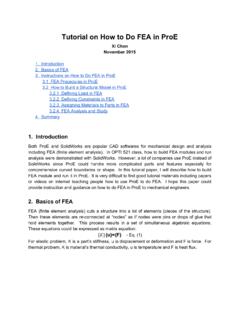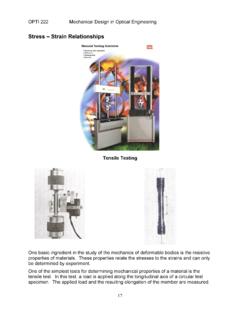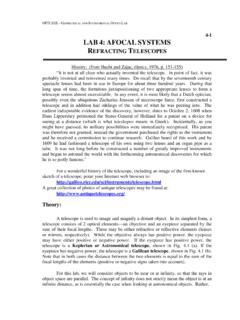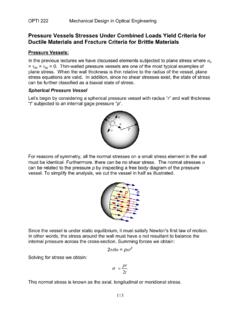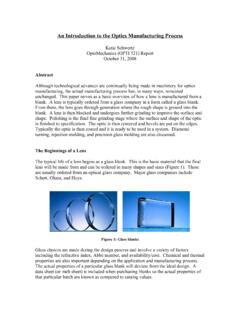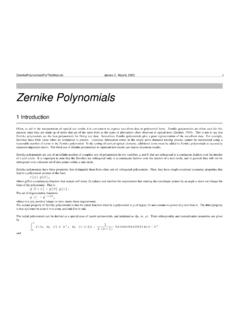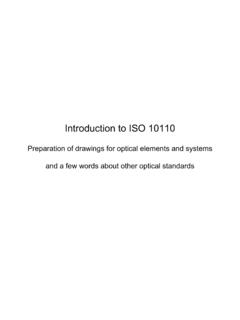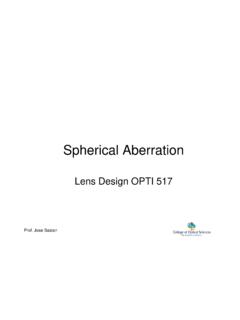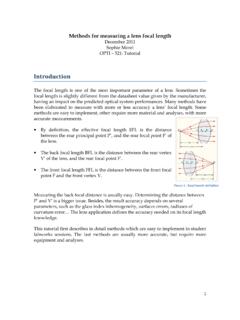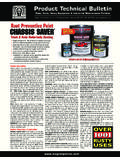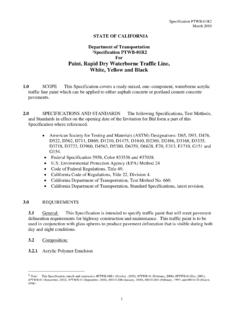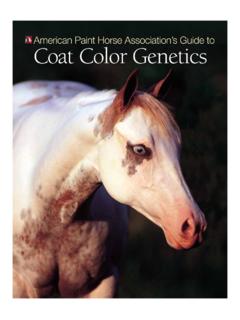Transcription of REVIEW ARTICLE Review of black surfaces for space-borne ...
1 REVIEW ARTICLER eview of black surfaces for space - borne infrared systemsM. J. Perskya)Lincoln Laboratory, Massachusetts Institute of Technology, 244 Wood Street, Lexington, Massachusetts02420-9108~Received 18 March 1998; accepted for publication 5 January 1999!Low reflectivity~ black !surface treatments for space - borne infrared systems are reviewed. Theuses of black surfaces in general, as well as for specific space - borne applications are of a wide variety of surface treatments with examples of experimental data tocharacterize performances are provided.
2 Specific treatments included are: Ames 24E paint; AZKO463~Sikkens, Cat-A-Lac!paint; Ball IR black paint; Chemglaze~Aeroglaze!Z306 and Z302 paints;Eccosorb 268E paint; Parsons black paint; black anodize; black Hardlub; black Hardcoat; MartinBlack; InfraBlack; Enhanced Martin black ; Ebonal C; Teflon; ion beam textured; applique s; blackchrome; black etched beryllium on beryllium; plasma sprayed boron on beryllium; plasma sprayedberyllium on beryllium; boron carbide on POCO graphite; and Kapton. Data presented for some butnot all of the surfaces include: spectrally integrated, 5 25mm hemispherical-directional reflectance;spectral reflectance at wavelengths between 2 and 500mm for a variety of incident angles from 5 to 80 ; and bidirectional reflectance at a number of wavelengths between 5 and 300mm for a varietyof incident angles from 0 to 80.
3 The instrumentation employed to obtain these data is brieflydescribed. Long term stability of optical performance, as well as manufacturing reproducibility isdemonstrated for several of the surfaces . Outgassing and atomic oxygen interaction information isalso included. Methodology for calorimetric measurement of hemispherical emittance as analternative to optical measurements is given. 1999 American Institute of INTRODUCTIONLow reflectivity1~ black ! surfaces have a number ofapplications for space - borne infrared instruments. Examplesare telescope housings and baffles where stray light reduc-tion is vital, and light shields and cold stops in infrared de-tector assemblies.
4 black surfaces are used on sources foron-board sensor calibrations and for measurement of spatialnonuniformity of imagers. Passive cooling of infrared sys-tems~detectors, telescopes, electronics subsystems!requiressurfaces that are efficient radiators to space . black surfacesplay an important role in the design of infrared seekers usedfor ballistic missile defense, and for satellite-based surveil-lance systems. Additionally, target identification requires adatabase of surface infrared ARTICLE is intended to be a broad REVIEW of blacksurfaces used for purposes such as these, and to provide datato illustrate optical performance.
5 Included are most of thepopular surfaces of the hundreds available to designers, aswell as new approaches that the reader may find of data obtained were by this author and by other workersin the field. References are cited for further information andadditional brief discussion of the uses of black surfaces is foundin Sec. II. Detailed descriptions of most of the surfaces cov-ered in this REVIEW are presented in Sec. III, including chemi-cal compositions and process specifications. Section IV dis-cusses substrate measurements are grouped by category: spectrallyintegrated, hemispherical-directional reflectance in Sec.
6 V;hemispherical emittance by calorimetry in Sec. VI; direc-tional reflectance as a function of wavelength and incidentangle in Sec. VII; bidirectional reflectance as a function ofwavelength and incident angle in Sec. VIII; and chemicalstability~outgassing and atomic oxygen interactions!in USES OF black SURFACESA space - borne telescope viewing dim objects must pro-tect against off-axis stray light from the Sun, Earth limb,Moon, as well as from its own housing. This is accomplishedby including a baffle assembly to restrict the angular accep-tance angle.
7 The design of the baffle needs to very carefullyweigh the benefits of diffuse versus specular vane example, diffuse surfaces tend to be more susceptible tooutgassing and particulate contamination of nearby surfacesthan do specular. However, with the specular approach slightdesign errors or manufacturing tolerances can be more can be a difficulty in maintaining the desired knifeedge when using paint that can build up on the edge. Somea!Electronic mail: OF SCIENTIFIC INSTRUMENTSVOLUME 70, NUMBER 5 MAY 199921930034-6748/99/70(5)/2193/25/$ 1999 American Institute of PhysicsDownloaded 22 Apr 2006 to Redistribution subject to AIP license or copyright, see the advanced treatments discussed here~ black etchedberyllium-on-beryllium, plasma sprayed boron-on-beryllium,plasma sprayed boron carbide-on-silicon carbides andplasma sprayed beryllium-on-beryllium!
8 Are intended fordiffuse-absorptive baffle surfaces that can withstand the me-chanical and chemical stability problems of space use andmaintain a sharp surfaces in which the energy is absorbed create afurther problem, the need to eliminate the heat now beingstored in the surface. This requirement, as well as the need todump heat from electronic units dictates efficient radiators tospace, another typical use of black certain applications the self radiation from the tele-scope or other parts of the instrument can determine thenoise level.
9 Cooling to reduce the noise level is typicallyaccomplished by cryogens which dictates the system willhave a limited lifetime. A potential solution is to launch thetelescope warm and use black surfaces radiating antisunwardto space providing radiative ,6 The need to verify that the laboratory calibration of aspace- borne spectrometer is still applicable during the actualflight leads to the requirement for a space qualified, highlyemissive, calibration reference source. In one application thesensor viewed targets deployed from the satellite solution for this scenario was thus a reference sourcethat would also be deployed from the sensor platform.
10 Thesource needed to be well characterized, and have a highlystable intensity. The requirement was an absolute intensityaccuracy of 15% at any wavelength and 5% when comparingband to band. Also, it should provide useful intensities overthree orders of dynamic of such an object, ifcommon to several programs, would allow comparisonsfrom flight to flight and to assist in investigating platform orinstrument the source is to be deployed into space the sensorsignal is due not only to the source self-emission but also tothe Solar image and Earthshine reflected from it.
